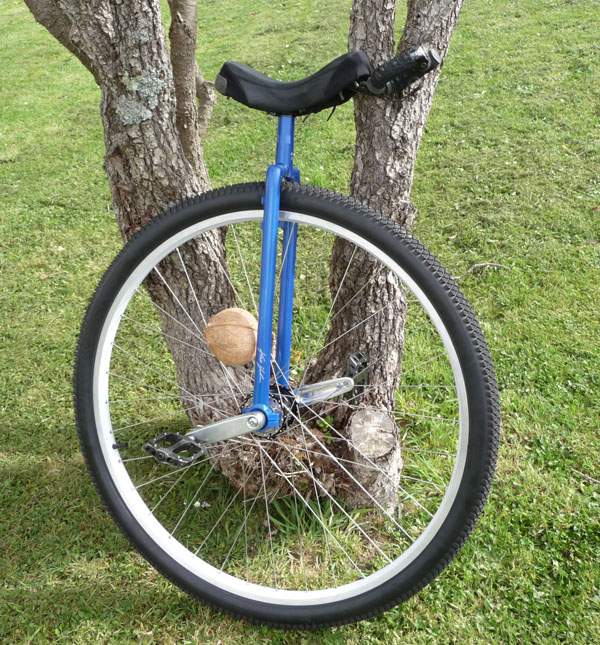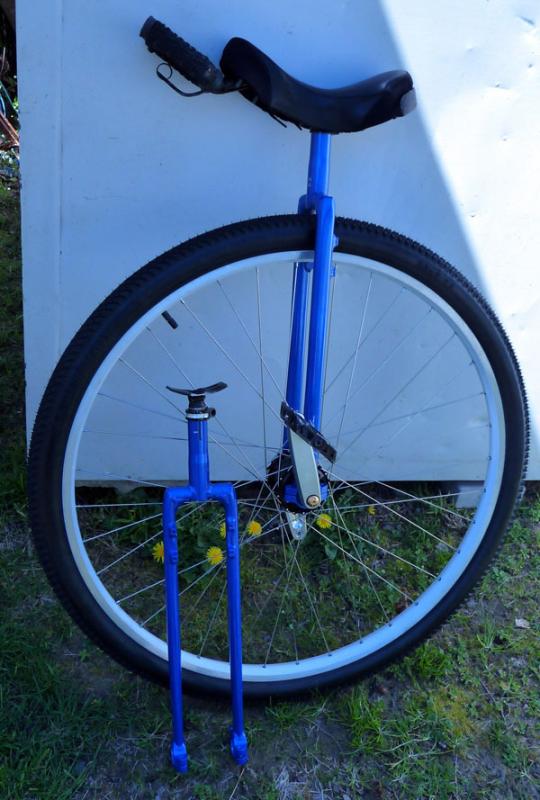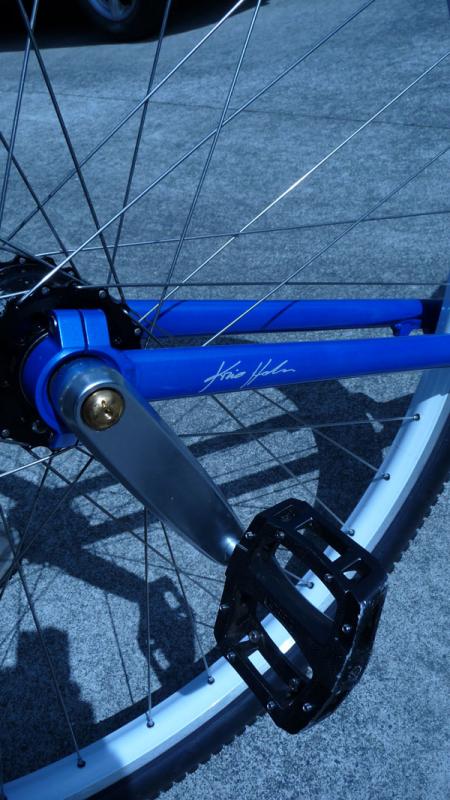I haven’t seen anyone post a review of the KH 36" Schlumpf yet so I thought I’d post one. My Schlumpf finally arrived after three months of to-ing and fro-ing.
I started off with a wheel, then had to wait for the frame shipment, and when that arrived, it was sent down to me when I was out of the country, and then when I finally got it all together, I stuck a seatpost into the frame and it got stuck, so I had to buy another frame after I got back in the country. Anyway, I finally received all the parts I needed to build it up on Thursday. Thanks UDC NZ!
The first thing I had to do was cut down the seatpost by about 1cm. The tubing is quite thick and took some effort to cut down. There is quite a long vertical slot for the clamped area, so no need to cut a longer slot.
This frame is tough. And very stiff. If anyone doubts how stiff, we wrestled with it, bashed it with a hammer, heated it with a paintstripper, and twisted it back and forths with a block of wood, all for over an hour to get the seatpost out of my first KH36" frame before giving up. Not just me, but some big guys at the bike shop had a go. The fork legs barely flexed through all this. No cracks or anything at the welds either.
Anyway, I didn’t have problems with the second KH 36" frame so I was able to finally ride it on Thursday.
I kitted it out with my usual GB4 handle, KH carbon seatbase and modified fusion saddle. And a few other of my favourite bits 
Specs
Handle: GB4
Seat: KH carbon base, modified fusion
Seatpost: Schlumpf aluminium
Frame: KH 36"
Hub: KH Schlumpf
Cranks: Quax aluminium 145mm
Pedals: Gusset Slim Jims
Spokes: UDC Stainless ?14Ga
Rim: Nimbus Stealth Pro
Tube: Coker 36"
Tyre: Nimbus Nightrider
The first ride I did was at the Wellington Velodrome. It’s a 333.33m velodrome with a banked edge. I couldn’t ride it on the banking so had to go along the flat inner part of the velodrome. Did a few laps and about 7secs faster than the 29" Schlumpf over a km. This thing definitely powers along on the flat! Went down to the Basin Reserve circuit after that to try a few laps of the course I used for my 24hr record. It took alot of effort rev it up to speed, but it was pretty bumpy and I was not able to wind it up at all. It seemed to handle the bumps better than the 29" Schlumpf, but there were so many potholes and glass and people to dodge that I gave up on the speed test.
Anyway, I went for my second ride today, and probably the first real test of the Schlumpf. It’s a ?30-something km circuit to Makara Beach and back which I regularly use for time trials. Not particularly hilly, but not as flat as RTL or Unicon 14 Marathon either. There is a short sharp climb up the road, followed by a gentle descent for a couple of km, then rolling all the way down to the beach. Lot’s of twisty turns and corners, so not a fast course. I’ve ridden this route a few thousand times (have been using it since high school), so it’s a good testing ground.
The first thing to note is that the Schlumpf is heavy! If you were to build one up, make sure you have the lightest wheelset available. It took some effort to accelerate out of corners and also to decelerate. I didn’t have brakes but that may be helpful I think.
Shifting was markedly better than the 29" Schlumpf. I think the new hubs engage more positively and solidly than the old road Schlumpf hub, but it’s more than that. Having ridden Tony Melton’s 36" Schlumpf (road hub), I found that shifted easier too. It’s probably more intuitive a jump between 1:1 and 1:1.5 mode in the 36" wheelsize than on the 29".
In fact, the problem was that the shifting was way too easy. I only had to think about shifting and I would find myself in the new gear. The other problem was that I had straight cranks, which scared me silly. I overtightened the shifter button on one side, and as a result, it’s stuck and I can’t adjust the buttons inwards. So I have this button sticking out very close to my ankle that I was petrified I would tap by accident.
The first part of my ride was spent wrestling with my Schlumph and trying to ride with my foot as far out of the pedal as possible. I didn’t get confident until I was half way to the ride and found that I was still alive (no accidental shifts). Once I hit the rolling section the Schlumpf really comes into it’s own.
It rides more like a bike than a unicycle. In fact, you need to ride it like a bike. I normally ride with a pretty low position, but I think to get full power into a schlumpf hub and lower your centre of gravity sufficiently, you need to have the exact same position as on a road bike. The GB4 was way too short. Ideally something like Pete Perons V-frame design should work well. I’m not a big fan of T-7 (too upright) and other extension bars that stick out all the way from the seatpost. I’m not an engineer, but something tells me that’s not a very good design 
The bike-like effect is basically down to the smoothness with which it rolls. This thing feels stable. The 29" Schlumpf is skittish and feels like it want’s to fly into the air everytime you hits a bump. You can go at a good speed on the 36" Schlumpf without feeling like you’re going fast. Not so on the 29" Schlumpf…if it feels like you’re going fast, it’s because you are.
To extend the bike comparison further…it rides like a very heavy bike. Like a DH mountainbike instead of a roadbike. It accelerates sluggishly, it decelerates with alot of effort. I had to really stand up off the pedals out of every corner in order to get up to speed again. However, if you can get enough momentum heading into a climb, you can crest over small rises quite easily.
The next thing is the frame. It worked great. It’s stiff, fairly light, and looked tidy. The only thing I didn’t like was the square crown design. It’s not as bad as the 1st and 2nd Gen Schlumpf frames, but like all square crown designs, if you are short, it can hit the back of your thighs or leg when you pedal. I only noticed it a couple of times, but probably not good for short people with fat or muscly thighs.
I hit the beach in a time of 42:00, which I was pretty happy with after spending half that distance experimenting and trying not to hit the shifter button by accident. By comparison, my Unguni Coker times are around 40-44min (at race speed), best ever road bike time 28.50. MTB times are about 30-32min.
The ride back was more pleasant. It was also rolling, but gently uphill overall, which had me less worried about the shifter button. I found the 145mm cranks ok in high gear up to about 5% gradients, after that I had to shift to the low gear. Unfortunately 145mm cranks on a Coker feels ridiculously long. So it was a case of either powering up in big gear, or plodding up in low gear. I think 125mm cranks might be better, as the 125mm cranks are a more useable low gear, but will probably need a few more rides before I make up my mind. The other option is to go super long, such as 160 or 170mm (like a bike), which might give you the leverage to get up just about anything in high gear. Singlespeed mountainbikers I know generally use 2:1 ratios and longer than usual 180-185mm cranks. Which I think would work out a similiar sort of gear to the 36" Schlumpf in 1:1.5 mode. So maybe the trick might be to use long cranks instead.
I got back from my ride in 1:28:59, which was slightly faster than my best Schlumpf 29" time of 1:29:18. Unguni Coker time 1:32:55 and roadbike time: 1hr08min. I think it’s definitely faster, but takes a lot of effort to ride compared to the 29"Schlumpf and 36" Unguni.
I’ll post an update once I’ve done some more riding. I think once I fix the shifter problem I’ll be a bit more confident at pushing this beast 


